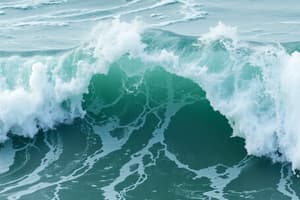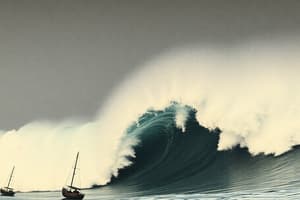Podcast
Questions and Answers
What is the general form of a wave represented by the equation?
What is the general form of a wave represented by the equation?
- y = Asin(ωt + kn)
- y = Asin(ωt - kn) (correct)
- y = Aω(kt + n)
- y = A + sin(ωt - kn)
What is the formula for calculating the speed of a transverse wave on a stretched string?
What is the formula for calculating the speed of a transverse wave on a stretched string?
- V = √(T/µ) (correct)
- V = √(F/µ)
- V = T/µ
- V = T²/µ
What happens to wave amplitude when moving from a rarer to a denser medium?
What happens to wave amplitude when moving from a rarer to a denser medium?
- Amplitude is doubled
- Amplitude is inverted
- Amplitude is halved
- Amplitude remains the same (correct)
In constructive interference, how is the resultant amplitude (AR) calculated when A₁ = A₂?
In constructive interference, how is the resultant amplitude (AR) calculated when A₁ = A₂?
What is the equation for power in wave mechanics?
What is the equation for power in wave mechanics?
In terms of intensity, what does the formula Imax = (√I₁ + √I₂)² calculate?
In terms of intensity, what does the formula Imax = (√I₁ + √I₂)² calculate?
Which formula describes the phase difference in wave propagation?
Which formula describes the phase difference in wave propagation?
What is the term for the coefficient that measures the amplitude of the reflected wave?
What is the term for the coefficient that measures the amplitude of the reflected wave?
Flashcards
Wave Velocity
Wave Velocity
The speed at which a wave travels through a medium.
Particle Velocity
Particle Velocity
The velocity of a particle in the medium as the wave passes through.
Speed of Transverse Wave on String
Speed of Transverse Wave on String
The speed of a wave traveling along a stretched string, determined by tension and mass.
Bulk Modulus
Bulk Modulus
Signup and view all the flashcards
Constructive Interference
Constructive Interference
Signup and view all the flashcards
Destructive Interference
Destructive Interference
Signup and view all the flashcards
Reflection Coefficient
Reflection Coefficient
Signup and view all the flashcards
Intensity
Intensity
Signup and view all the flashcards
Study Notes
Waves
-
General form of a wave: y = A sin(ωt – kx) where A is amplitude, ω is angular frequency, t is time, k is wave number, and x is position.
-
Wave Number (k): k = 2π/λ, where λ is wavelength.
-
Angular Frequency (ω): ω = 2πf, where f is frequency.
-
Relationship between particle velocity (vp) and wave velocity (vw): vp = -vw(slope)
-
Differential form of a simple harmonic wave (SHW): d²y/dt² = -ω²y
-
Intensity (I) of a wave: I = (1/2)μω²A²
-
Wave speed on a stretched string: v = √(T/μ) where T is tension and μ is linear mass density.
-
Newton's formula for the speed of sound: v = √(γP/ρ), where γ is adiabatic index, P is pressure, and ρ is density
Other Wave Concepts
-
Laplace formula: vs = √γRT/M
-
Relative and Absolute loudness: L(dB) = 10log₁₀(I/I₀), where I is intensity and I₀ is a reference intensity (typically the threshold of hearing).
-
Wave speed (v) and frequency (f): v = fλ
-
Spherical waves: y = A₀ sin(ωt ± kx)
-
Cylindrical waves: y = A₀ sin(ωt ± kx)/r
-
Reflection at a fixed end: yr = -Asin(ωt + kx)
-
Reflection at a free end: yr = Asin(ωt + kx)
-
Constructive interference: Amplitude of reflected wave + Amplitude of transmitted wave = AR + AT
-
Destructive interference: AR = (√V₂ - √V₁)/√(√V₂ + √V₁)
-
Amplitude of reflected wave (AR): AR = (V₂ - V₁)/(V₂ + V₁) * A₀
-
Amplitude of transmitted wave (AT) : AT = 2 * V₁/(V₁ + V₂) * A₀
-
Wave Equations for Reflected & Transmitted Waves at Boundaries (Denser/Rarer Medium): Equations for wave amplitude are presented for various boundary scenarios.
Studying That Suits You
Use AI to generate personalized quizzes and flashcards to suit your learning preferences.




